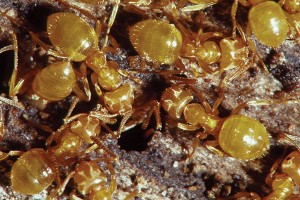
Photo courtesy of and copyrighted by: Gene White, pmimages@earthlink.net
Citronella ant (Lasius interjectus)
Formerly Genus: Acanthomyops, this larger yellow ant is a subterranean saboteur of structures.
- Description: Workers are polymorphic, 0.10- to 0.15-in. long. They’re yellow and emanate a lemon verbena, or citronella odor, upon being threatened or crushed. They have 12-segmented antennae. The initial antennal segment is evenly aligned with the top of the head. They possess a single-node pedicel joining the thorax and abdomen. The hairs on the head, thorax and abdomen stand up, keeping in line with the Genus name, which translates to “shaggy.” Winged reproductives are about the size of two workers and vary from light yellow to light reddish-brown, with smoky-tinted wings.
- Life cycle: Complete metamorphosis (egg, larva, pupa and adult). Alates, or winged king and queen ants, take nocturnal nuptial flights.
- Food: This species does not typically take human food, but prefers to feed on honeydew excretions taken from aphids and the mealy bugs on shrub roots.
- Unique behaviors: Locating colonies near rich food sources, citronella ants are not known to actively forage. However, they can emerge in well-heated structures en masse as swarmers, and workers forage during cold weather.
- Significance: Swarmers and workers can enter structures through cracks and construction deficits, and can be mistaken for termites. Ant colonies and erratic seasonal swarms might be supported by soil next to foundations and under slabs being consistently warmed.
Dr. Mitchell, D.O., Ph.D., M.P.H., B.C.E., a board-certified physician and entomologist, is principal technical specialist for PestWest Environmental, as well as PMP’s Technical Editor. He can be reached at docmitchell@northcoastmedia.net or 515-333-8923.
Leave A Comment